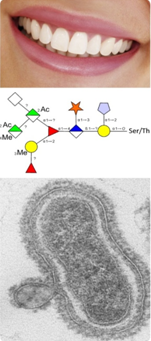Glycoprofiling of the oral pathogen Tannerella forsythia for identifying novel strategies in pathogenicity
SUPERVISOR: CHRISTINA SCHÄFFER
Project assigned to: MARKUS TOMEK
Background.
 The anaerobic oral biofilm-forming pathogen Tannerella forsythia (Tf) is one of the main etiological agents of periodontitis. Because of the increasing frequencies with which bacterial glycosylation systems are seen in pathogenic species, they have come under enhanced scrutiny; especially the "sweet"cell envelope of pathogens contribute to their cross-talk with the hosts. Consequently, for the study of virulence mechanisms and the associated development of therapeutic strategies, a molecular understanding of the glycans displayed in the cell envelope of pathogens is necessary. Although a complete genome sequence is available for T. forsythia, relatively little is known about the cell biology and glycobiology of this pathogen.
The anaerobic oral biofilm-forming pathogen Tannerella forsythia (Tf) is one of the main etiological agents of periodontitis. Because of the increasing frequencies with which bacterial glycosylation systems are seen in pathogenic species, they have come under enhanced scrutiny; especially the "sweet"cell envelope of pathogens contribute to their cross-talk with the hosts. Consequently, for the study of virulence mechanisms and the associated development of therapeutic strategies, a molecular understanding of the glycans displayed in the cell envelope of pathogens is necessary. Although a complete genome sequence is available for T. forsythia, relatively little is known about the cell biology and glycobiology of this pathogen.
T. forsythia is the only Gram-negative bacterium known to possess a 2D crystalline glycoprotein layer (S-layer) as outermost cell envelope layer. The T. forsythia S-layer is a virulence factor and contributes to delaying the host immune defense. It is evident that the uniqueness of the T. forsythia cell envelope is defined by its glycobiology. The S-layer is unique in being formed by co-assembly of two different proteins, which are modified with a specific type of complex oligosaccharides at multiple sites. A novel type of rough lipopolysaccharide is predicted to anchor the S-layer glycoprotein assembly to the outer membrane. The T. forsythia outer membrane is dominated by additional antigenic, high molecular-mass glycoproteins. Some of these as well as the S-layer glycoproteins are up-regulated in the biofilm life-style of T. forsythia.
Aims and methods.
The present research proposal is designed to get insight into the T. forsythia S-layer O-glycosylation system and its scope at the molecular level. We have evidence that several T. forsythia proteins are modified with this specific S-layer O-glycan, pinpointing to a glycosylation scenario of general relevance. We hypothesize that the S-layer glycosylation system of T. forsythia affects a wide number of different target proteins and, thus, is of high relevance for the bacterium. Considering the presence of a fucose and a modified pseudaminic acid residue in the T. forsythia S-layer glycan, it is conceivable that this glycan does not only have a demonstrated impact on the bacterium′s life style and, hence, development of periodontal disease, but also is a mediator of pathogenicity.
This project aims at characterizing the virulence potential of selected glycoproteins from the T. forsythia cell envelope and includes
1) Expression and purification of the selected fucosyl-proteins from T. forsythia
2) Immunology studies with selected fucosyl-proteins
3) Determination of the roles of selected fucosyl-proteins in biofilm formation
Profiling of this general O-glycosylation system of T. forsythia at the molecular level and investigating how it affects the physiology of T. forsythia may reveal novel pathogenic strategies in Gram-negative organisms. This, in the future, may constitute new targets for interfering with the pathogen′s ability to establish infection in periodontal disease and for developing of novel diagnostic tools.
Posch, G; Pabst, M; Brecker, L; Altmann, F; Messner, P; Schäffer, C. (2011) Characterization and scope of S-layer protein O-glycosylation in Tannerella forsythia. J Biol Chem. 286(44):38714-38724
Sekot, G; Posch, G; Messner, P; Matejka, M; Rausch-Fan, X; Andrukhov, O; Schäffer, C. (2011) Potential of the Tannerella forsythia S-layer to Delay the Immune Response. J Dent Res. 90(1):109-114
Sekot, G; Posch, G; Oh, YJ; Zayni, S; Mayer, H; Pum, D; Messner, P; Hinterdorfer, P; Schäffer, C. (2011) Analysis of the cell surface layer ultrastructure of the oral pathogen Tannerella forsythia. Arch Microbiol. DOI 10.1007/s00203-012-0792-3
Veith, P; O′Brien-Simpson, N; Tan, Y; Djatmiko, D; Dashper, S; Reynolds, E. (2009) Outer Membrane Proteome and Antigens of Tannerella forsythia. J. Proteome Res. (8):4279-4292
Pham, T; Roy, S; Noirel, J; Douglas, J; Wright, P; Stafford, G. (2010) A quantitative proteomic analysis of biofilm adaptation by the periodontal pathogen Tannerella forsythia. Proteomics. 10:3130-3141
Sharma, A. (2011) Virulence mechanisms of Tannerella forsythia. Periodontol 2000; 54(1):106-116
